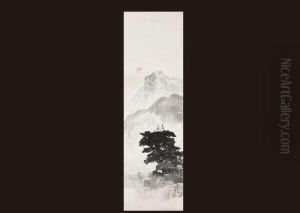Hirafuku Hyakusui Paintings
Hirafuku Hyakusui was a distinguished Japanese painter born in 1877, in Nihonmatsu, Fukushima Prefecture, Japan. His artistic journey began in a culturally rich environment, influenced by his father, Hirafuku Suian, who was also a notable nihonga painter. This familial backdrop provided Hyakusui with an early exposure to the world of traditional Japanese art, setting the stage for his future contributions to the nihonga movement.
Hyakusui's body of work is celebrated for its incorporation of traditional Japanese techniques with a modern sensibility, making him a pivotal figure in the transition of Japanese art into the modern era. He studied under several masters, including Kano Hogai and Hashimoto Gaho, which allowed him to refine his skills and develop a unique artistic voice. His education was further enriched by his time at Tokyo Bijutsu Gakko (now Tokyo University of the Arts), where he absorbed influences from various art movements and styles.
Throughout his career, Hyakusui was known for his landscapes and portraits that exuded a sense of tranquility and aesthetic elegance. His ability to capture the essence of the natural world, combined with a profound sense of spirituality, resonated deeply with audiences. He was a member of the Nihon Bijutsuin (Japan Art Institute), where he contributed significantly to the development and promotion of nihonga painting.
Hyakusui's dedication to his craft and his innovative approach to traditional Japanese painting earned him numerous accolades and a lasting legacy in the art world. He passed away in 1933, but his work continues to be celebrated for its beauty and historical significance, representing a bridge between the past and future of Japanese art.

